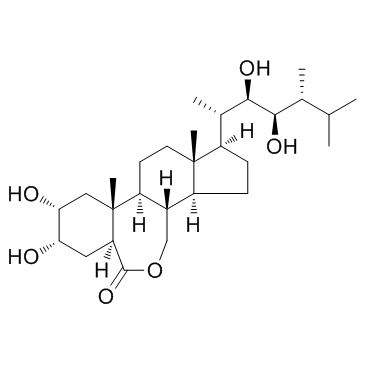78821-43-9
| Name | 24-epi-brassinolide |
|---|---|
| Synonyms |
CH09964 EPIBRASSINOLIDE
(3aS,5S,6R,7aR,7bS,9aS,10R,12aS,12bS)-10-[(1S,2R,3R,4S)-2,3-dihydroxy-1,4,5-trimethylhexyl]hexadecahydro-5,6-dihydroxy-7a,9a-dimethyl-3H-benzo[c]indeno[5,4-e]oxepin-3-one 1,6-Dioxacyclodeca-3,8-dien (1R,3aS,3bS,6aS,8S,9R,10aR,10bS,12aS)-1-[(1S,2R,3R,4S)-2,3-dihydroxy-1,4,5-trimethylhexyl]hexadecahydro-8,9-dihydroxy-10a,12a-dimethyl-6H-benz[c]indeno[5,4-e]oxepin-6-one 24-Epicastasterone 3.24-EPIBRASSINOLIDE (3aS,5S,6R,7aR,7bS,9aS,10R,12aS,12bS)-10-[(2S,3R,4R,5R)-3,4-Dihydroxy-5,6-dimethyl-2-heptanyl]-5,6-dihydroxy-7a,9a-dimethylhexadecahydro-3H-benzo[c]indeno[5,4-e]oxepin-3-one (2a,3a,5a,22R,23R,24S)-2,3,22,23-Tetrahydroxy-B-homo-7-oxaergostan-6-one (3aS,5S,6R,7aR,7bS,9aS,10R,12aS,12bS)-10-[(2S,3R,4R,5S)-3,4-Dihydroxy-5,6-dimethylheptan-2-yl]-5,6-dihydroxy-7a,9a-dimethylhexadecahydro-3H-benzo[c]indeno[5,4-e]oxepin-3-one EPI BRASSINOLIDE 24-EPIBRASSINOLIDE 2α,3α,22,23-tetrahydroxy-24-methyl-B-homo-7-oxa-5α-cholestan-6-one cis,cis-1,6-Dioxa-3,8-cyclodecadien 1,6-dioxa-cyclodeca-3,8-diene 4-Epicastasterone (3aS,5S,6R,7aR,7bS,9aS,10R,12aS,12bS)-10-[(2S,3R,4R,5S)-3,4-Dihydroxy-5,6-dimethyl-2-heptanyl]-5,6-dihydroxy-7a,9a-dimethylhexadecahydro-3H-benzo[c]indeno[5,4-e]oxepin-3-one (3aS,5S,6R,7aR,7bS,9aS,10R,12aS,12bS)-10-[(2S,3R,4R,5S)-3,4-Dihydroxy-5,6-dimethylheptan-2-yl]-5,6-dihydroxy-7a,9a-dimethylhexadecahydro-3H-benzo[c]indeno[5,4-e]oxepin-3-on (2α,3α,5α,22R,23R,24S)-2,3,22,23-Tetrahydroxy-B-homo-7-oxaergostan-6-one 2a,3a,22,23-Tetrahydroxy-24-methyl-B-homo-7-oxa-5a-cholestan-6-one Epibrassinolide(24-Epibrassinolide) Brassinolide(epibrassinolide,Homobrassinolide) BRASSINOLIDE(BR) 2,4-Epibrassinolide 3H-Benz[c]indeno[5,4-e]oxepin-3-one, 10-[(1S,2R,3R,4S)-2,3-dihydroxy-1,4,5-trimethylhexyl]hexadecahydro-5,6-dihydroxy-7a,9a-dimethyl-, (3aS,5S,6R,7aR,7bS,9aS,10R,12aS,12bS)- 3H-Benz[c]indeno[5,4-e]oxepin-3-one, 10-[(1S,2R,3R,4R)-2,3-dihydroxy-1,4,5-trimethylhexyl]hexadecahydro-5,6-dihydroxy-7a,9a-dimethyl-, (3aS,5S,6R,7aR,7bS,9aS,10R,12aS,12bS)- .(22R,23R,24R)-2 Brassinolide Epibrassinolide 24-(R)-EPIBRASSINOLIDE brassinosteroid |
| Description | Epibrassinolide is a natural brassinosteroid (BR) derivative, is a plant regulator with a similar structure to mammalian steroids. Epibrassinolide is a potential apoptotic inducer in various cancer cells without affecting the non-tumor cell growth. |
|---|---|
| Related Catalog | |
| Target |
Plant growth regulator, Apoptosis inducer[1] |
| In Vitro | Epibrassinolide (EBR) is a biologically active compound of the brassinosteroids, steroid-derived plant growth regulator family. Cells are incubated with various doses (0-100 μM) of Epibrassinolide for 24 or 48 h and cell viability is determined by MTT assay. Epibrassinolide induced cell viability loss in dose- and time-dependent manner compared to untreated samples in LNCaP and DU145 prostate cancer cells. Increasing concentrations of Epibrassinolide is more effective on LNCaP cell viability loss than DU145 cells suggesting that androgen-dependent cells are more sensitive to Epibrassinolide than androgen-independent prostate cancer cells. In further experiments, 25 μM Epibrassinolide is selected due to its moderate cytotoxic effect on both cell lines. The effect of Epibrassinolide treatment is examined on cell proliferation by counting the cell number within 96 h. A higher and earlier inhibition of cell proliferation is observed in LNCaP than DU145 cells[1]. |
| Cell Assay | LNCaP (CRL-1740) and DU145 (CRL-2698) human prostate cancer cell lines are used. PNT1a normal prostate epithelial cell line is used. Cells are grown in RPMI 1640 medium, supplemented with 10 % fetal bovine serum, 10,000 U penicillin/mL and 10 mg streptomycin/mL. Cells are cultured at 37°C in a humidified 5 % CO2 incubator (HERA cell 150). Cells are seeded overnight and then treated with the desired drug concentrations. Cells are seeded at 1×104 density per well in 96-well plates and exposed to various concentrations of Epibrassinolide for 24 and 48 h. 10 μL MTT dye (5 mg/mL) is added to each well and cells are kept at 37°C for 4 h. The resulting formazan crystals are solubilized in 200 μL DMSO. The density of the solubilized formazan is read at 570 nm spectrophotometrically[1]. |
| References |
| Density | 1.1±0.1 g/cm3 |
|---|---|
| Boiling Point | 633.7±55.0 °C at 760 mmHg |
| Melting Point | 256°C |
| Molecular Formula | C28H48O6 |
| Molecular Weight | 480.677 |
| Flash Point | 202.3±25.0 °C |
| Exact Mass | 480.345093 |
| PSA | 107.22000 |
| LogP | 3.12 |
| Vapour Pressure | 0.0±4.2 mmHg at 25°C |
| Index of Refraction | 1.536 |
| Storage condition | −20°C |
| Personal Protective Equipment | Eyeshields;Gloves;type N95 (US);type P1 (EN143) respirator filter |
|---|---|
| Risk Phrases | 22-36/37/38 |
| Safety Phrases | 22-36/37/39-45 |
| RIDADR | NONH for all modes of transport |
| WGK Germany | 3 |


